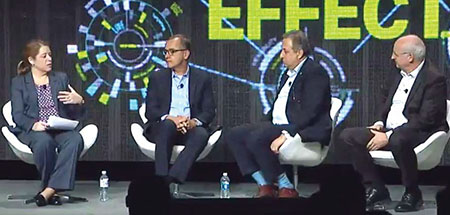Consumers Getting Out Ahead of UHD
LAS VEGAS—We’re taught to look before we leap, but many consumers are jumping head first into 4K/UHD technology believing it is the future for television content. This is occurring despite the amount of television content available to showcase in the higher resolution is still relatively small.

(L to R) Michelle Abraham leads the panel featuring Hanno Basse, Thierry Fautier and Paul Higgis
The proof is in the numbers, however. During a special session sponsored by Huawei at the 2017 NAB Show titled “Accelerated UHD Adoption,” moderator Michelle Abraham from S&P Global Intelligence cited reports that sales and shipments of 4K/UHD TV sets were outpacing the data for HD at its outset. Now in its third year, 4KTV sets have sold four times as many sets compared to HD in its first three years. It’s going global, as the United States, Italy, Germany, France, the U.K., Sweden, Japan, Korea and China are all hovering around 10-percent household penetration for 4KTVs.
“The 4K screen is becoming quite prolific,” said Paul Higgs, chief strategy officer, video product line for Chinese consumer electronics giant Huawei during the panel. “Customers are now using it as their first choice if they’re making a buying decision.”
SPORTS IS KEY
While many customers appear to be future-proofing themselves with these purchases, the availability of content will still be a key motivator for UHD’s acceptance. One area in particular could be critical for its future.
“What’s still lagging quite a bit is creating high-quality content in sports,” Hanno Basse, president and chairman of the UHD Alliance and CTO, 20th Century Fox Film Corp., told the panel. Basse explained the cost of a UHD production has been a preventative element thus far, with new cameras, switchers and other production elements like graphics needed. “We need to figure out how to get production costs down and also need to figure out some responsible compensation for that,” Basse said.
One solution could be charging for UHD broadcasts of popular sporting events with a pay-per-view model, Higgs suggested. Basse agreed that there was a market “willing to pay for that extra quality.”
The professional video industry's #1 source for news, trends and product and tech information. Sign up below.
That willingness could grow the more people become exposed to UHD and in particular become more aware of the advantages of technology like high-dynamic range and wide color gamut. “With HDR, seeing is believing and it’s not something that you can put in perspective or in a TV commercial,” Basse said. “You have to make sure people actually go to the store and actually see it.”
TV isn’t the only technology that could be reliant on UHD, as Thierry Fautier, president and chair of the Ultra HD Forum, and Harmonic’s vice president of video strategy, suggested. “VR today shows that in order to have an immersive experience, 4K is the minimum production level, and distribution with the legacy devices we have today is what is needed,” he said. “I think what we do here is not just for TV, it’s for VR.”
The panel made it clear that consumers will have plenty of options to enjoy UHD and they are clearly preparing themselves for it. It is a question of when, not if, UHD becomes as ubiquitous as HD is today.
